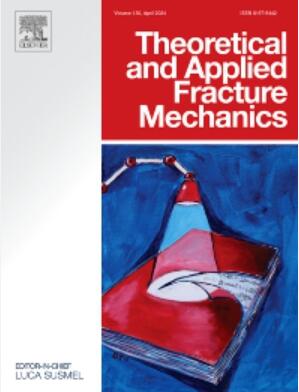建立了湿热老化环境下聚氨酯胶粘接结构开裂失效准则
IF 5.6
2区 工程技术
Q1 ENGINEERING, MECHANICAL
引用次数: 0
摘要
在车辆的使用过程中,粘接构件的性能通常长期受到湿热老化和复杂应力状态的影响。因此,具有实际环境适用性的胶粘剂结构失效判据对于预防断裂和优化胶粘剂性能具有重要意义。本研究选择聚氨酯胶粘剂(ISR-7008)/铝合金接头作为研究对象,选择- 40 ~ 85℃/30 ~ 95% RH作为循环湿热老化环境。采用改进的Arcan夹具对不同加载角度(0 ~ 90°)的接头进行了准静态拉伸试验,模拟了复杂的应力状态。得到了接头的应力应变曲线、初始破坏载荷和面积,并结合有限元法进一步得到了粘接层的应力分布。然后,基于比值法选取尺寸为MPa的应力分量,采用线性组合法计算等效应力;通过迭代选择不受复合应力状态影响的等效应力作为粘接层的破坏准则。通过对破坏模式和初始破坏载荷的比较,发现偏应力J*3第3不变量与偏应力J*2第2不变量的比值可以预测湿热老化后接头的破坏强度。结果表明,在复杂应力状态下,预测结果与实验结果的最大相对误差分别为14.44%(未时效)和17.35%(热湿时效720 h)。通过单搭接节点的拉伸试验,验证了该失效准则的有效性和对不同结构节点的适用性。该失效准则为车身粘接结构的失效预测提供了一种新的思路。本文章由计算机程序翻译,如有差异,请以英文原文为准。
A failure criterion developed for crack of polyurethane adhesive bonding structures under hygrothermal aging environment
In the service process of vehicles, the performance of adhesive components is usually affected by hygrothermal aging and complex stress states for a long time. Therefore, the failure criterion of adhesive structure with practical environmental applicability is very important for fracture prevention and adhesive performance optimization. In this study, polyurethane adhesive (ISR-7008)/aluminium alloy joints were selected as the study object, and −40 ∼ 85 °C/30 ∼ 95 % RH was selected as the cyclic hygrothermal aging environment. The joints were subjected to cyclic hygrothermal aging for 0 ∼ 720 h. The quasi-static tensile tests of joints with different loading angles (0 ∼ 90°) were carried out by the improved Arcan fixture to simulate the complex stress states. The stress–strain curve, initial failure load and area of the joint were obtained, and the stress distribution of the adhesive layer was further obtained by combining the finite element method. Then, based on the ratio method, the stress components with a dimension of MPa are selected, and the equivalent stress is calculated by linear combination. The equivalent stress that is not affected by the complex stress states is selected as the failure criterion of the adhesive layer by iteration. By comparing the failure mode and the initial failure load, it is found that the ratio of 3rd invariants of the deviatoric stress J*3 and 2nd invariants of the deviatoric stress J*2 can predict the failure strength of the joint after hygrothermal aging. The results show that the maximal relative errors between the predicted results and the experimental results under complex stress states are 14.44 % (unaged) and 17.35 % (hygrothermal aging for 720 h). The validity of the failure criterion and the applicability of different structural joints are verified by the tensile test of single lap joints. This failure criterion provides a new idea for the failure prediction of vehicle body adhesive structure.
求助全文
通过发布文献求助,成功后即可免费获取论文全文。
去求助
来源期刊

Theoretical and Applied Fracture Mechanics
工程技术-工程:机械
CiteScore
8.40
自引率
18.90%
发文量
435
审稿时长
37 days
期刊介绍:
Theoretical and Applied Fracture Mechanics'' aims & scopes have been re-designed to cover both the theoretical, applied, and numerical aspects associated with those cracking related phenomena taking place, at a micro-, meso-, and macroscopic level, in materials/components/structures of any kind.
The journal aims to cover the cracking/mechanical behaviour of materials/components/structures in those situations involving both time-independent and time-dependent system of external forces/moments (such as, for instance, quasi-static, impulsive, impact, blasting, creep, contact, and fatigue loading). Since, under the above circumstances, the mechanical behaviour of cracked materials/components/structures is also affected by the environmental conditions, the journal would consider also those theoretical/experimental research works investigating the effect of external variables such as, for instance, the effect of corrosive environments as well as of high/low-temperature.
 求助内容:
求助内容: 应助结果提醒方式:
应助结果提醒方式:


